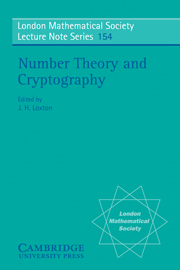Book contents
- Frontmatter
- Contents
- Contributors
- Introduction
- I NUMBER THEORETIC ASPECTS OF CRYPTOLOGY
- 1 Some mathematical aspects of recent advances in cryptology
- 2 Quadratic fields and cryptography
- 3 Parallel algorithms for integer factorisation
- 4 An open architecture number sieve
- 5 Algorithms for finite fields
- 6 Notes on continued fractions and recurrence sequences
- II CRYPTOGRAPHIC DEVICES AND APPLICATIONS
- PART III DIOPHANTINE ANALYSIS
4 - An open architecture number sieve
Published online by Cambridge University Press: 05 May 2013
- Frontmatter
- Contents
- Contributors
- Introduction
- I NUMBER THEORETIC ASPECTS OF CRYPTOLOGY
- 1 Some mathematical aspects of recent advances in cryptology
- 2 Quadratic fields and cryptography
- 3 Parallel algorithms for integer factorisation
- 4 An open architecture number sieve
- 5 Algorithms for finite fields
- 6 Notes on continued fractions and recurrence sequences
- II CRYPTOGRAPHIC DEVICES AND APPLICATIONS
- PART III DIOPHANTINE ANALYSIS
Summary
The technique of ‘sieving’ has been known since the time of Eratosthenes, and has been used to solve problems involving systems of linear congruences since the end of the eighteenth century. As a wide range of number theoretic problems can be converted into sieving problems, considerable effort has been expended in constructing machines which are fast enough to solve problems that are otherwise intractable. Most notable is the work of D. H. Lehmer, who pioneered the development of automatic sieving hardware in the 1920's. The latest development in automated sieving is the ‘Open Architecture Sieve System’ (OASiS). The system features a specially-designed computer capable of testing possible solutions to a system of linear congruences at a rate of over 200 million numbers per second. Unlike current sieve devices, the OASiS hardware is capable of assuming a variety of configurations, allowing the user to alter the number of congruences being tested in hardware and their size. It also increases the speed at which many sieving problems are solved by automatically optimizing sieving whenever one or more congruences with a single acceptable residue class are present. In this paper, we trace the development of the automatic sieving system from its beginnings to the present day. We also present some results of problems that have been run using OASiS, which includes extending the tables of known pseudo-squares and pseudo-cubes, finding periodic continued fractions with long periods, and finding polynomials which have a high density of prime values.
- Type
- Chapter
- Information
- Number Theory and Cryptography , pp. 38 - 75Publisher: Cambridge University PressPrint publication year: 1990
- 4
- Cited by



